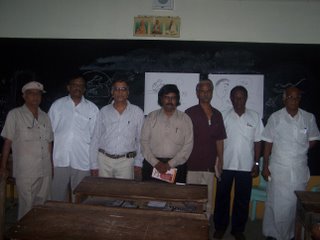
Minutes of the meeting:
Event : Meeting of the members of the ponniyin selvan yahoogroup (http://groups.yahoo.com/group/ponniyinselvan/) - The Perfect outfit to bring Historical facts to light
Scholors of various historical fields also attended.
Date : 4th July 2006, 6PM IST
Venue : Sri Ramakrishna mutt school, T. Nagar, Chennai.
Guests: Dr. Sathyamurthy, Suptt Archlgist, ASI (Retd)
T. N. Ramachandran, Epigraphist
Dr. Dasarathan, Palm-leaf specialist
Dr. Sathyanarayanan, Deputy Registrar, Sankara University
Mr. T. K. V. Rajan, eminent media personality
Mr. Swaminathan, thinnai.com
Mr. Ganesa Nadar
Sivapathasekaran (SPS) started the meeting introducing the various guests and members.
SPS also gave a short speech on how there has been a fusion that made the 'Ponniyin Selvan' group successful. He pointed out that the group was started and has the active participation of people from youngsters from the IT related industries. He pointed out that the shared enthusiasm of scholars to preserve ancient artifacts, and the techniques that could be provided by the youngsters could provide immense benefits. He also described how the efforts of the group moved from just being a literary group to interests in history and preservation of ancient tamil artifacts.
Dr. Sathyamurthy, Suptt Archeologist, ASI, then talked about the huge number of temples that are in ruins. He said that 60% of all stone-carvings in Indian history would be of the tamil origin. He noted the interesting fact that there was no oral-passage of knowledge (like vedas were passed orally down traditions) in the tamil culture, and suggested that this was proof that tamil had a well defined script far earlier than the north indian languages. He sadly observed that the governments mistakenly regard the historical tamil artifacts as non-secular, as they are mostly found in places of worship. He observed that the priest community should be more aware that simple stones lying in the temples could be of monumental importance, and hence should be involved in an effort to protect whatever is left of these ruined, un-protected artifacts.
Mr. T. N. Ramachandran then stole the show. He explained the distinction between hieroglyphics and a well defined phonetics based script. He showed with examples that hieroglyphs were a raw form of language, while phonetical scripts were more advanced, as there was no space for differing interpretations in the latter. He said, thus tamil was a more advanced language than what prevailed in the indus valley civilizations. He warned, however, that even though evidences about the antiquity of tamil/brahmi, and superiority over the indus valley civilizations are emerging day by day, we should not fall prey to over-enthusiasm and hype up not-so-well-defined-facts. This is because we are being watched with awe by all over the world, and we should not err in our claims. Rather we should let the facts talk for themselves.
Dr. Dasarathan, then talked of the unclaimed 'kalvettu'kkal in various parts of the country, and his rendezvous with "Kalvettum Katthirikkayum"! He also described how palm-leaf-writing could be of historical importance, and how many such historically significant palm-leaf-writings are spread throughout the land, without attempts at interpretations, which could significantly lead to a change of our current understanding of history.
Dr. Sathyanarayanan, then spoke at length about his interest in 'Ponniyin Selvan' and his association with Dr. Sathyamurthy. He offered to recommend to Sankara University, for a certificate course, if the group could come up with a write-up and syllabi. He said, this kind of work was more of the type that would have impressed Maha-periyava as the university was originally conceived to learn and enhance sanskrit works.
Mr. T. K. V. Rajan, then described the efforts by the media with regard to preservation of historical artifacts. He described some interesting anecdotes from "Kalvettu sollum kathai".
Mr. Swaminathan of thinnai.com and Ganesha Nadar expressed thier appreciation for the group.
Following small talks by various members on thier association with 'Ponniyin Selvan' and the group, the stage was set to discuss the proposed ephigraphy course.
With inputs from Mr. T. N. Ramachandran and Mr. Sathyanarayanan, SPS deftly steered the group discussion on the proposed course syllabi, duration, certification and timing & venue.
The decisions are as below:
- The course will of six month duration
- The course will include theory and field work
- Classes to be conducted for two hours on Saturdays and Sundays
- Students *must* attend at least 16 of the 24 theory classes in the first 3 months
- Certificates will be provided by Sankara University at the end of six months
- Venue not conclusively decided
Action items:
Team at large :
- Coordinate and followup on the efforts
- (To be assigned to somebody - SPS?) Create a write-up about the course to apply for
certification to Sankrara University
SPS :
- Decide and let the participants know about 4 venues, out of which one convenient venue
should be chosen.
Mr. T. N. Ramachandran:
- Prepare syllabi and field work curriculum
The meeting ended with informal networking and a short photo-session.

No comments:
Post a Comment